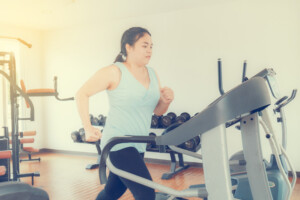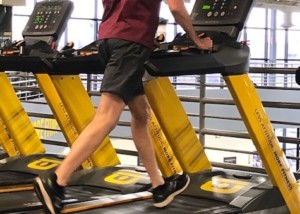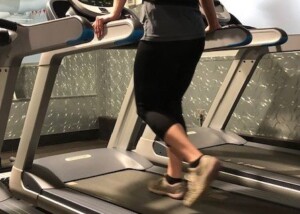Find out just how big a difference there is between jogging on a treadmill while holding on vs. hands off.
If you’ve been holding onto the treadmill while jogging, you’ve hardly done anything to make yourself a better runner outside, on the court or in the field.
Just because there’s a place to put your hands on the treadmill doesn’t mean you should do this when running on it.
When you run or jog outside, on the street, in a park, an athletic field or on a basketball court, your upper body moves completely differently than how it’s positioned if you’re holding onto a treadmill.
When you hold onto a treadmill while jogging, your upper body is locked in place, moving minimally.
If you were to run outside or anywhere other than on a machine, your upper body would be fully engaged.
This is the way you should run: the upper body moving in synch with the lower body, in unison, arms swinging.
This natural motion is completely tossed when you hold onto a treadmill—even if you’re in poor physical condition, overweight, older, what-have-you.
Holding the Front Bar while Jogging Makes You Lean Forward
Some runners who hold onto a treadmill lean INTO the machine when their hands are on the front bar.
However, holding onto the side bar doesn’t make things right, either.
Even if you’re a slow jogger, you simply should not hold on. Your arms are supposed to swing gently at your sides. Even toddlers, when “running,” know this basic rule of the human body.
By holding onto the bar in front, you’ll remove workload from your core.
Yes, the core works when you run or jog naturally without clinging onto anything for support.
If you’ve seen fit-looking people holding onto a treadmill while doing their make-believe running, don’t think for a second that this externally supported movement contributes to their nice physique.
A person can get a good body by strength training alone, coupled with a smart diet.
And again, holding onto the side of the machine isn’t any better. The body’s natural movement patterns still get disrupted.
“Holding on may giver joggers a sense of ‘more intensity,’ but it actually results in a less effective workout,” says John Whyte, MD, board certified internist in Washington, DC, and author of “Is This Normal? The Essential Guide to Middle Age and Beyond.”
If you’re up to jogging on a treadmill but feel out of shape, you will do yourself a giant disservice by holding on.
Instead, start out slowly with baby steps. Go 3.5 mph or even slower, zero incline.

Shutterstock/MikeBiTa
If your feet or some other area begins hurting or aching, then walk for a while.
But do not hold onto the treadmill when running.
This is a terrible habit. Even if you get dizzy, do not hold on.
Just go slower, hands free, arms swinging naturally, and give your body a chance to acclimate and adjust.

Dr. Whyte is the chief medical officer of webmd.com. Prior, he was the chief medical expert for almost a decade at Discovery Channel.
 Lorra Garrick is a former personal trainer certified through the American Council on Exercise. At Bally Total Fitness she trained women and men of all ages for fat loss, muscle building, fitness and improved health.
Lorra Garrick is a former personal trainer certified through the American Council on Exercise. At Bally Total Fitness she trained women and men of all ages for fat loss, muscle building, fitness and improved health.
.










































